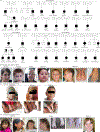Disruption of RFX family transcription factors causes autism, attention-deficit/hyperactivity disorder, intellectual disability, and dysregulated behavior
- PMID: 33658631
- PMCID: PMC9472083
- DOI: 10.1038/s41436-021-01114-z
Disruption of RFX family transcription factors causes autism, attention-deficit/hyperactivity disorder, intellectual disability, and dysregulated behavior
Abstract
Purpose: We describe a novel neurobehavioral phenotype of autism spectrum disorder (ASD), intellectual disability, and/or attention-deficit/hyperactivity disorder (ADHD) associated with de novo or inherited deleterious variants in members of the RFX family of genes. RFX genes are evolutionarily conserved transcription factors that act as master regulators of central nervous system development and ciliogenesis.
Methods: We assembled a cohort of 38 individuals (from 33 unrelated families) with de novo variants in RFX3, RFX4, and RFX7. We describe their common clinical phenotypes and present bioinformatic analyses of expression patterns and downstream targets of these genes as they relate to other neurodevelopmental risk genes.
Results: These individuals share neurobehavioral features including ASD, intellectual disability, and/or ADHD; other frequent features include hypersensitivity to sensory stimuli and sleep problems. RFX3, RFX4, and RFX7 are strongly expressed in developing and adult human brain, and X-box binding motifs as well as RFX ChIP-seq peaks are enriched in the cis-regulatory regions of known ASD risk genes.
Conclusion: These results establish a likely role of deleterious variation in RFX3, RFX4, and RFX7 in cases of monogenic intellectual disability, ADHD and ASD, and position these genes as potentially critical transcriptional regulators of neurobiological pathways associated with neurodevelopmental disease pathogenesis.
Figures



References
-
- Sanders SJ, Murtha MT, Gupta AR, et al. De novo mutations revealed by whole-exome sequencing are strongly associated with autism. Nature. 2012;485(7397):237–241. http://www.ncbi.nlm.nih.gov/RefSeq/; Accessed April 24, 2020. - PMC - PubMed
Publication types
MeSH terms
Substances
Grants and funding
LinkOut - more resources
Full Text Sources
Medical
Molecular Biology Databases

